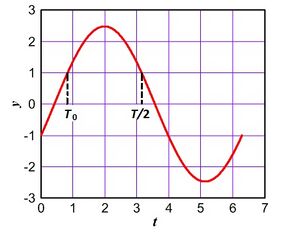Biryukov equation
In the study of dynamical systems, the Biryukov equation (or Biryukov oscillator), named after Vadim Biryukov (1946), is a non-linear second-order differential equation used to model damped oscillators.[1]
The equation is given by [math]\displaystyle{ \frac{d^2 y}{dt^2}+f(y)\frac{dy}{dt}+y=0, \qquad\qquad (1) }[/math]
where ƒ(y) is a piecewise constant function which is positive, except for small y as
[math]\displaystyle{ \begin{align} & f(y) = \begin{cases} -F, & |y|\le Y_0; \\[4pt] F, & |y|\gt Y_0. \end{cases} \\[6pt] & F = \text{const.} \gt 0, \quad Y_0 = \text{const.} \gt 0. \end{align} }[/math]
Eq. (1) is a special case of the Lienard equation; it describes the auto-oscillations.
Solution (1) at a separate time intervals when f(y) is constant is given by[2]
[math]\displaystyle{ y_k(t) = A_{1,k}\exp(s_{1,k}t) + A_{2,k}\exp(s_{2,k}t) \qquad\qquad (2) }[/math]
where exp denotes the exponential function. Here [math]\displaystyle{ s_k = \begin{cases} \displaystyle \frac{F}{2}\mp\sqrt{ \left(\frac{F}{2}\right)^2-1}, & |y|\lt Y_0; \\[2pt] \displaystyle -\frac{F}{2}\mp\sqrt{ \left(\frac{F}{2}\right)^2-1} & \text{otherwise.} \end{cases} }[/math] Expression (2) can be used for real and complex values of sk.
The first half-period’s solution at [math]\displaystyle{ y(0)=\pm Y_0 }[/math] is
[math]\displaystyle{ \begin{align}
y(t) &= \begin{cases}
y_1(t), & 0\le t\lt T_0; \\[4pt]
y_2(t), & \displaystyle T_0\le t\lt \frac{T}{2}. \end{cases} \\[4pt]
y_1(t) &= A_{1,k}\cdot \exp (s_{1,k}t)+A_{2,k}\cdot \exp (s_{2,k}t), \\[2pt]
y_2(t) &= A_{3,k}\cdot \exp(s_{3,k}t)+A_{4,k}\cdot \exp (s_{4,k}t).
\end{align} }[/math]
The second half-period’s solution is
[math]\displaystyle{ y(t)= \begin{cases} \displaystyle -y_1\left(t-\frac{T}{2}\right), & \displaystyle \frac{T}{2} \le t \lt \frac{T}{2} + T_0; \\[4pt] \displaystyle -y_2\left(t-\frac{T}{2}\right), & \displaystyle \frac{T}{2} + T_0 \le t \lt T. \end{cases} }[/math]
The solution contains four constants of integration A1, A2, A3, A4, the period T and the boundary T0 between y1(t) and y2(t) needs to be found. A boundary condition is derived from continuity of y(t) and dy/dt.[3]
Solution of (1) in the stationary mode thus is obtained by solving a system of algebraic equations as
[math]\displaystyle{ \begin{array}{ll} & y_1(0) = -Y_0 & y_1(T_0) = Y_0 \\[6pt] & y_2(T_0) = Y_0 & y_2 \! \left(\tfrac{T}{2}\right) = Y_0 \\[6pt] & \displaystyle \left.\frac{dy_1}{dt}\right|_{T_0} = \left.\frac{dy_2}{dt}\right|_{T_0} \qquad & \displaystyle \left.\frac{dy_1}{dt}\right|_{0} = -\left.\frac{dy_2}{dt}\right|_\frac{T}{2} \end{array} }[/math]
The integration constants are obtained by the Levenberg–Marquardt algorithm. With [math]\displaystyle{ f(y)=\mu(-1+y^2) }[/math], [math]\displaystyle{ \mu = \text{const.} \gt 0, }[/math] Eq. (1) named Van der Pol oscillator. Its solution cannot be expressed by elementary functions in closed form.
References
- ↑ H. P. Gavin, The Levenberg-Marquardt method for nonlinear least squares curve-fitting problems (MATLAB implementation included)
- ↑ Arrowsmith D. K., Place C. M. Dynamical Systems. Differential equations, maps and chaotic behavior. Chapman & Hall, (1992)
- ↑ Pilipenko A. M., and Biryukov V. N. «Investigation of Modern Numerical Analysis Methods of Self-Oscillatory Circuits Efficiency», Journal of Radio Electronics, No 9, (2013). http://jre.cplire.ru/jre/aug13/9/text-engl.html
 |



